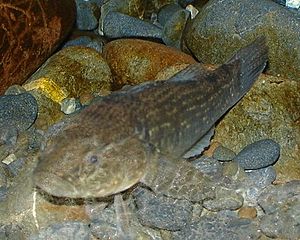Giant bully facts for kids
Quick facts for kids Giant bully |
|
|---|---|
 |
|
| Conservation status | |
| Scientific classification |
The giant bully (Gobiomorphus gobioides), also known by its Māori names tītarakura or tīpokopoko, is a type of fish found only in New Zealand. It belongs to the Eleotridae family, which includes many types of "sleepy cod" or "gudgeons". This fish is the biggest of all the bully species.
Giant bullies can grow quite large, sometimes over 25 cm (10 in) (about 10 inches) long. However, most of them are usually between 12–15 cm (4.7–5.9 in) (5 to 6 inches) long.
Contents
About the Giant Bully
The giant bully is a fascinating fish that lives in New Zealand. It's known for its size compared to other bully fish. These fish are an important part of New Zealand's freshwater and coastal ecosystems.
Where They Live
Adult giant bullies usually live near the coast. You can find them in different types of water. They live in freshwater rivers and streams, as well as in tidal areas. They also like estuaries, which are places where rivers meet the sea.
What Makes Them Special
The giant bully looks a lot like the common bully. Common bullies can grow up to 15 cm or 5.9 in (about 6 inches). One way to tell them apart is by their dorsal (back) fins. The giant bully usually has six spines on its dorsal fin. The common bully, on the other hand, usually has seven spines.
Life Cycle and Reproduction
Scientists don't know a lot about how giant bullies reproduce. However, they are thought to be a diadromous species. This means they move between fresh water and salt water during their lives. It's believed that their young, called larvae, spend some time growing up in the sea. After a while, they likely move back into freshwater or coastal areas as they get older.
Conservation Status
The giant bully's conservation status is listed as "Least Concern" by the IUCN. This means that, for now, their populations are stable. They are not currently at high risk of disappearing.


